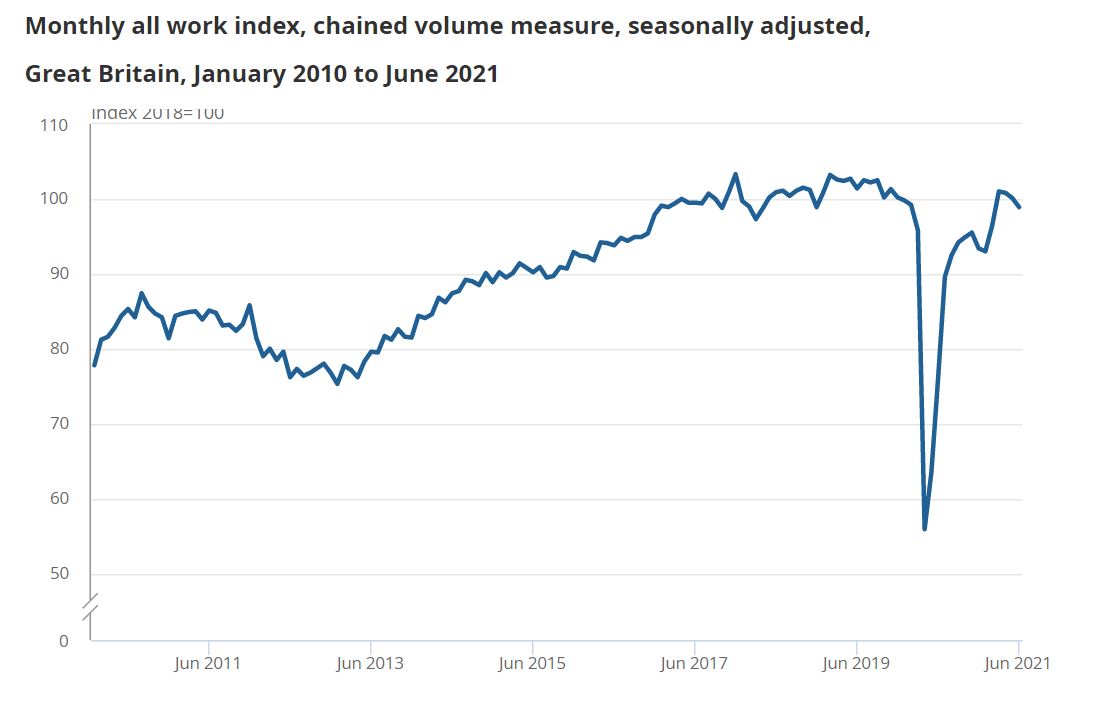The Office for National Statistics (ONS) has published its latest figure for construction output in the period April to June 2021.
Monthly construction output fell by 1.3% in June 2021, because of a decline in repair and maintenance (4.2%) offset by a small increase in new work (0.5%).
Construction output in June 2021 was 0.3% (£39 million) below the February 2020 pre-coronavirus (COVID-19) pandemic level; new work was 2.1% (£188 million) below this level, while repair and maintenance was 3.1% (£149 million) above.
In contrast to the monthly fall, quarterly construction output grew by 3.3% in Quarter 2 (Apr to June) 2021 compared with Quarter 1 (Jan to Mar) 2021; both new work (3.9%) and repair and maintenance (2.3%) saw increases.
Total construction new orders grew by 17.6% (£1,998 million) in Quarter 2 2021 compared with Quarter 1 2021; total new orders recovered in Quarter 2 2021 to above its pre-pandemic level for the first time at 1.6% (£214 million) above the Quarter 1 2020 level.
The annual rate of construction output price growth was 3.4% in June 2021; this was the strongest annual rate of construction output price growth since August 2019 (3.5%).
Monthly construction output fell for the third consecutive month in June 2021, by 1.3%. This is the largest monthly decline since December 2020 when output fell 2.2%. As shown in Table 1, this monthly fall means output has returned to below the pre-coronavirus (COVID-19) pandemic level in February 2020 (0.3% below).
Despite the three monthly falls in growth for the months within Quarter 2 (Apr to June) 2021, quarterly growth increased by 3.3% which, apart from Quarter 3 (July to Sept) 2020, is the strongest quarterly growth since Quarter 3 2013 (3.6%). The strong quarterly growth is partly a by-product of the weak January 2021 in the base period.
Commenting on the latest data from the ONS, Stuart Law, CEO of the Assetz group, said:
“Difficulties accessing raw materials, labour shortages, increased transportation costs and the realities of post-Brexit trade have resulted in the perfect storm for the construction industry.
“With private housebuilders starting to feel the strain more recently, these issues must not be ignored given the potential knock-on effects a significant decrease in housing construction would have on the wider market.
“SME housebuilders in particular face significant challenges with suppliers favouring bigger housebuilders with large purchasing agreements for raw materials over their smaller peers.
“With expectations that house price growth will pick up pace again over the remainder of the year and well into 2022, shortages in new housing stock will only serve to inflate prices further – possibly outstripping the record levels seen this Spring which would be very disappointing for many first-time buyers and those looking to upsize in the near future.
“These risks to the wider market make it all the more crucial that housebuilders are afforded the support required to achieve the Government’s target of building 300,000 new homes a year. To add to these complications, we have no certainty right now on the end of CE certification and the replacement UK certification scheme needed by the end of the year to help avoid even more material shortages and problems for builders.
“Nonetheless, we’ve certainly seen an appetite from builders to deliver more housing, having received hundreds of millions of pounds worth of loan applications for housebuilding projects over recent months.
“However, significant developments, such as the simplification of planning processes and improved access to funding, are needed to make housebuilders more resilient to current challenges and, ultimately, enable them to best meet the nation’s housing needs.”



There is a major shortage of tradesman now we have EU workers going back after Brexit and many building material costs are up 40%. My local builders suppliers is like a ghost town because of it.
You must be logged in to like or dislike this comments.
Click to login
Don't have an account? Click here to register